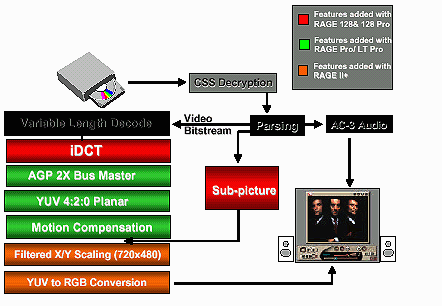Texture Compression
When S3 first introduced support for S3TC the market was stunned by the potential that was seemingly just sitting there. Since that announcement, there hasn't been too much support for the standard, also known as DirectX Texture Compression (DXTC) which is natively supported in Direct3D and, through an extension, supported in OpenGL. However the support is growing and since the Rage 128 Pro supports DXTC with its 6 to 1 compression algorithm, you can add ATI to that list.
The Rage 128 Pro, like the original Rage 128, features support for textures of up to 2048 x 2048 pixels in size. Although there isn't a game that makes use of such a large texture, the texture sizes will continue to increase as games become more and more realistic. For this reason the chip's support for texture compression is definitely a move in the right direction. While it won't be the deciding factor in your buying decision it does help the industry move forward.
In this respect, texture compression can be equated with features such as hardware transforming & lighting or Environment Mapped Bump Mapping (EMBM). While they may not be features that are fully taken advantage of in current games, hardware support for them is a step forward for the industry as a whole. The ball must start rolling somewhere and once it does the entire industry benefits. It's refreshing to see ATI contribute to the industry by supporting DXTC and, as we already know, they aren't the only ones that have already pledged support for it. Even 3dfx, with their own texture compression algorithms, has already announced support for DXTC in their upcoming next generation product.
DVD Decoding
While we praised the Matrox G400 for its DVDMax function, going from Matrox's software DVD to ATI's hardware accelerated MPEG2/DVD decoding, we noticed a world of difference not only in performance but in image quality, as well.

Like the Rage 128, the Rage 128 Pro provides for hardware motion compensation, an industry "buzzwords," -- what does it mean? The amount of CPU power required to decode a scene varies from one scene to the next. While a one system configuration will have no problems decoding a few scenes once the complexity of the decoding increases (ATI gave the example of an interlaced music video at 60 fields per second versus 24 fps for film) that same system may exhibit a significant drop in frame rate during these complex decoding processes and will thus produce jerky playback.
Hardware motion compensation takes this into account and helps provide playback at 100% speed without resorting to dropping frames or reducing quality in order to reduce CPU load. While hardware accelerated motion compensation does not take the place of a hardware MPEG2/DVD decoder it does aid systems in the playback of MPEG2/DVD video sources.
The hardware accelerated motion compensation of the Rage 128 Pro does aid quality considerably. It helped produce a very smooth picture that is superior to any software-only solution and was closer to the level of our own set top DVD solution.










0 Comments
View All Comments